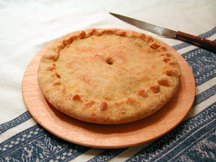Last night I tried out a new recipe (a modern one for crab soup, from Chef David Young's cookbook), and that got me thinking about the process I used to interpret medieval recipes. It's really pretty straightforward, but seeing as I'm not the most organized person in the world, it helps keeps me from making mistakes and makes sure I have all the information I need to put the recipes on my website.
[Note for any readers who participate in SCA Arts and Sciences competitions: following this sort of process will also help you document your recipe properly. I'll add notes in brackets where applicable.]
1. Select a Recipe
There are all sorts of ways to do this. You can use a medieval cookbook from a library or bookstore, use one of the many books available free online, or even use my searchable index of cookbooks to find recipes that use a given ingredient.
What's important here is to start with a medieval recipe. If you start with a modern recipe then there isn't much chance you'll end up with something medieval.
Write down or print out the recipe, making sure you spell the words exactly as given in the source.
[You should probably write down a sentence or two explaining why you chose the recipe, like "I had read that turnips were popular in the winter", or "I wanted to make one of the more popular medieval chicken dishes, but wasn't pleased with the versions I'd had before". Make sure you write down the source of the recipe as well.]
[It's also a very good idea at this point to look for versions of the same recipe in other medieval cookbooks. A simple Google search on the title will sometimes turn up . If you're using the Medieval Cookbook Search then sometimes links to other versions will be given at the bottom after the recipe text. Copy these down as well.]
2. Read & Markup
The idea here is to go over the recipe a couple of times, highlighting all the ingredients needed. This serves a number of purposes: it helps familiarize you with the recipe, it lets you know what you'll need to make it, and it identifies any weird steps or ingredients that you may need to look up. This step can be especially important for recipes written in Middle English or some equally obscure language.
[Here you might want to make a note about any hard-to-find ingredients, or unusual combinations of ingredients. Also, if there are other versions of the recipe, compare them to the one you've selected. You might want to combine them into an "average" recipe, or switch to use one of them instead.]
highlighting the ingredients
3. Print a Working Copy
It should have the recipe at the top, along with a list of the ingredients. Keep this close at hand in the kitchen, along with a pen or pencil.
working copy
4. Cook & Taste
Follow the recipe as written, even if you think it's a bit strange. Make sure to write down the quantities of the ingredients you use, along with any places where you did things differently from the original recipe.
Make notes about the good, the bad, and the weird.
not really the recipe above, but it's pretty
5. Share
While sharing the food is nice, sharing your final recipe is even better. Write out a final version of the recipe and post it on a website or email it to friends (or email it to me!).
[By this point you've got all the information you need for your A&S documentation. Add a couple of sentences to link the parts together, format it neatly, check the spelling, set the font to something readable, and you're pretty much done.]
Oh, here is the link to my interpretation of the example recipe above.






1 comment:
Great advice! Those recipes can be intimidating!
Post a Comment